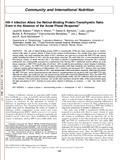| dc.contributor.author | Baeten, JM | |
| dc.contributor.author | Wener, MH | |
| dc.contributor.author | Bankson, DD | |
| dc.contributor.author | Lavreys, L | |
| dc.contributor.author | Richardson, BA | |
| dc.contributor.author | Mandaliya, K | |
| dc.contributor.author | Bwayo, JJ | |
| dc.contributor.author | McClelland, R | |
| dc.date.accessioned | 2013-06-29T10:02:20Z | |
| dc.date.available | 2013-06-29T10:02:20Z | |
| dc.date.issued | 2005 | |
| dc.identifier.citation | ; Baeten JM, Wener MH, Bankson DD, Lavreys L, Richardson BA, Mandaliya K, Bwayo JJ, McClelland RSHIV-1 infection alters the retinol-binding protein:transthyretin ratio even in the absence of the acute phase response.;J Nutr. 2006 Jun;136(6):1624-9. | en |
| dc.identifier.uri | http://www.ncbi.nlm.nih.gov/pubmed/16702331 | |
| dc.identifier.uri | http://erepository.uonbi.ac.ke:8080/xmlui/handle/123456789/42332 | |
| dc.description.abstract | he ratio of retinol-binding protein (RBP) to transthyretin (TTR) has been proposed as an indirect method with which to assess vitamin A status in the context of inflammation. Few studies have been conducted among adults, and none examined the effect of HIV-1 infection. Our goal was to assess the RBP:TTR ratio among adults, including the effects of HIV-1 and the acute phase response. We used data from a cross-sectional study of 600 Kenyan women, of whom 400 had HIV-1. The effect of vitamin A supplementation among the HIV-1-infected participants was subsequently assessed in a randomized trial. Among HIV-1-uninfected women without an acute phase response, a RBP:TTR cut-off value of 0.25 had approximately 80% sensitivity and specificity to detect vitamin A deficiency (retinol <0.70 micromol/L). No RBP:TTR cut-off value demonstrated both high sensitivity and specificity among HIV-1 infected women without evidence of inflammation. HIV-1 infection and advanced HIV-1 disease were associated with higher RBP:TTR ratios. The effect of HIV-1 was independent of the acute phase response, which also increased the RBP:TTR ratio. Serum retinol increased with vitamin A supplementation among those with a low RBP:TTR ratio, although the effect was small and was not present among those with concurrent inflammation. Thus, the RBP:TTR ratio has modest ability to predict vitamin A deficiency among healthy adults, but HIV-1 infection alters the ratio, even in the absence of the acute phase response. Our results raise questions about the utility of this measurement given the high prevalence of HIV-1 infection in areas where vitamin A deficiency is common. | en |
| dc.language.iso | en | en |
| dc.publisher | University of Nairobi, | en |
| dc.title | HIV-1 infection alters the retinol-binding protein:transthyretin ratio even in the absence of the acute phase response. | en |
| dc.type | Article | en |
| local.publisher | College of Health Sciences, | en |


